A supra is a traditional Georgian feast. It’s an important part of Georgian social culture where people get together and revel over toasts and copious amounts of Georgian food. The term supra literally means “table cloth” and is perhaps in reference to the sheer abundance of Georgian dishes that cover every inch of the dining table.
A proper supra lasts for many hours and is usually held to celebrate an event like a birthday or wedding. It’s led by a tamada or toastmaster who proposes a series of lavish toasts between glasses of Georgian wine and mouthfuls of sumptuous Georgian dishes like khinkali, khachapuri, mtsvadi, and khashlama.
Don’t expect to eat everything because Georgian culture dictates that no guest should ever be left wanting. Clear your plate and expect more servings to be bestowed upon you.
To Georgians, dinner guests are exalted as “blessings from God” so travelers invited to a supra should consider themselves lucky. This sense of abundance, hospitality, togetherness, and gratitude is part of what makes Georgian food and culture so inviting.
GEORGIAN FOOD QUICK LINKS
If you’re planning a trip to Georgia and want to really dig into Georgian cuisine, then you may be interested in going on a food tour.
TOURS & OTHER SERVICES
- Georgian Food Tours: Food and Wine/Drinking Tours in Georgia
- eSIM: Georgia eSIM
Save This on Pinterest!
No time to read this article on Georgian food? Click on the save button and pin it for later!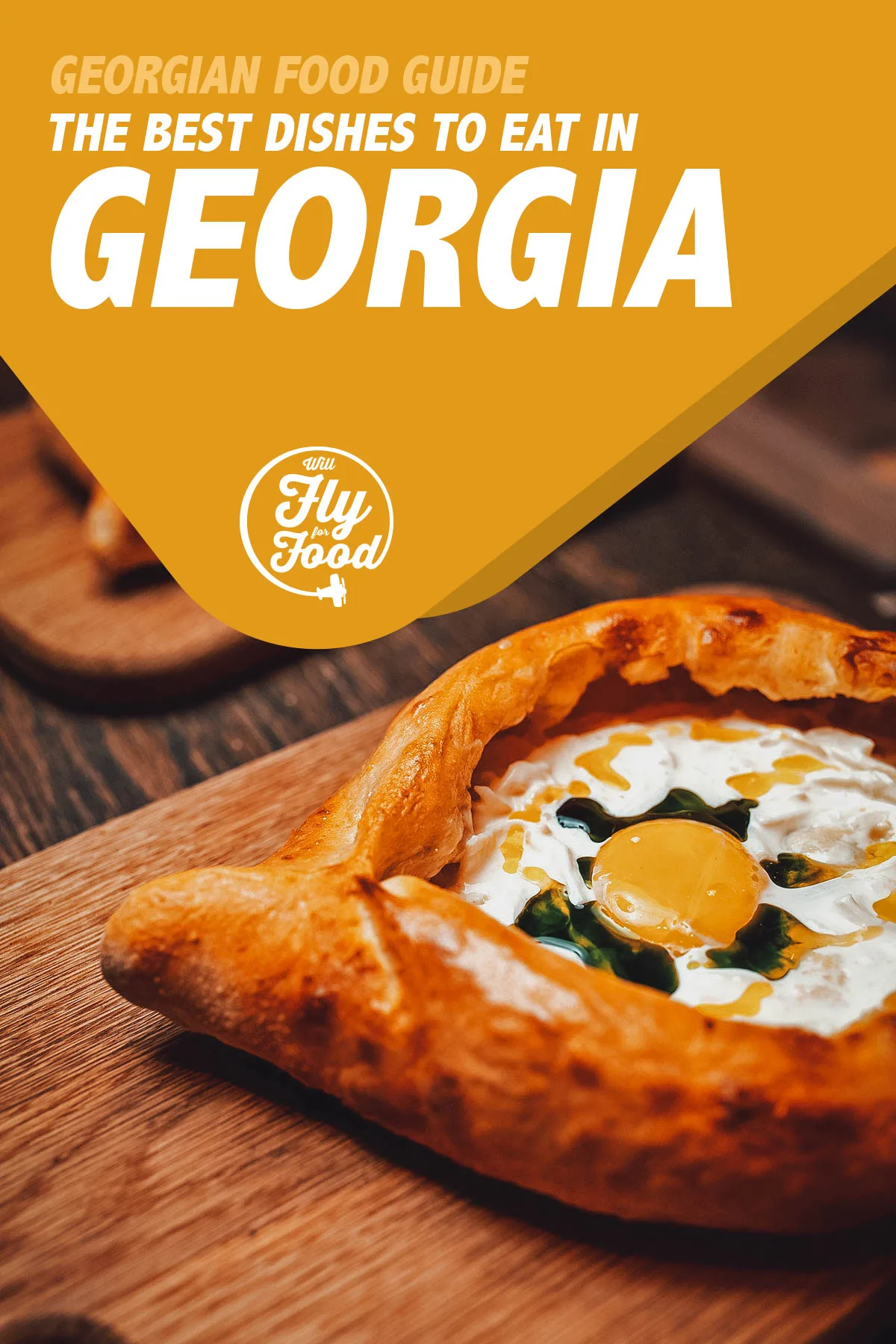
Photo by KatyaKiseleva
WHAT IS TRADITIONAL GEORGIAN FOOD?
Georgia is a small country that lies at the intersection of Western Asia and Eastern Europe. Its position along the Silk Road has led to an assimilation of flavors from the Greeks, Turks, Mongols, Arabs, and Persians. Thanks to this influx of culinary influences, Georgian food is diverse and can vary greatly from region to region.
Western Georgian food is said to have been influenced by Turkish cuisine while Iranian influences are more prevalent in the east. In the west, Georgian-style cornbread (mchadi) and poultry like chicken and turkey are favored while meat dishes made with pork, beef, or mutton are more prominent in the east. Easterners also prefer white bread baked in traditional clay ovens called toné.
Throughout Georgia, using the freshest locally-sourced produce is an obsession and perhaps a major reason why regional differences have persisted over the centuries.
Common ingredients used in Georgian cooking include walnuts, Georgian cheeses, sour fruit leather (tklapi), cherry plums (tkemali), red chili paste (ajika), and a spice blend called khmeli-suneli.
MUST-TRY GEORGIAN DISHES
Like a supra, a list of 20 dishes can be difficult to get through, so this article on the food in Georgia has been organized by category to make it easier to digest. Click on a link to jump to any section of the guide.
GEORGIAN STARTERS / SIDES
1. Khinkali
Other than khachapuri, there’s no better way to start this Georgian food guide than with khinkali. Khinkali is one of the most popular dishes in Georgian cuisine and considered by many to be a national dish.
Khinkali (or hinkali, xinkali) refers to Georgian meat-filled soup dumplings made with knobs of dough filled with a brothy mixture of pork and beef (or lamb). They can be made with other fillings as well like vegetables, mashed potatoes, mushrooms, and cheese, but the most common versions are stuffed with spiced ground meat.
To prepare, the uncooked meat mixture is wrapped inside the dough. When the soup dumplings are cooked, the juices from the meat become trapped inside the dumpling. Warm water or broth is often added to the meat mixture to make it even juicier.
Khinkali are similar to Shanghainese xiao long bao, except they’re boiled instead of steamed and made with a thicker skin. They’re also consumed a little differently.
To eat, the dumpling is sprinkled with black pepper and then picked up by its stem by hand. The diner takes a small bite from the side of the top to suck out the hot broth before digging into the filling. Unlike xiao long bao which is consumed in its entirety, the doughy stems of khinkali are usually discarded.
Khinkali originated from the mountain regions of Pshavi, Mtiuleti, Tusheti, and Khevsureti but it’s now widely consumed throughout Georgia. They’re a popular Georgian comfort food and often served towards the end of supras.
RECIPE: Khinkali
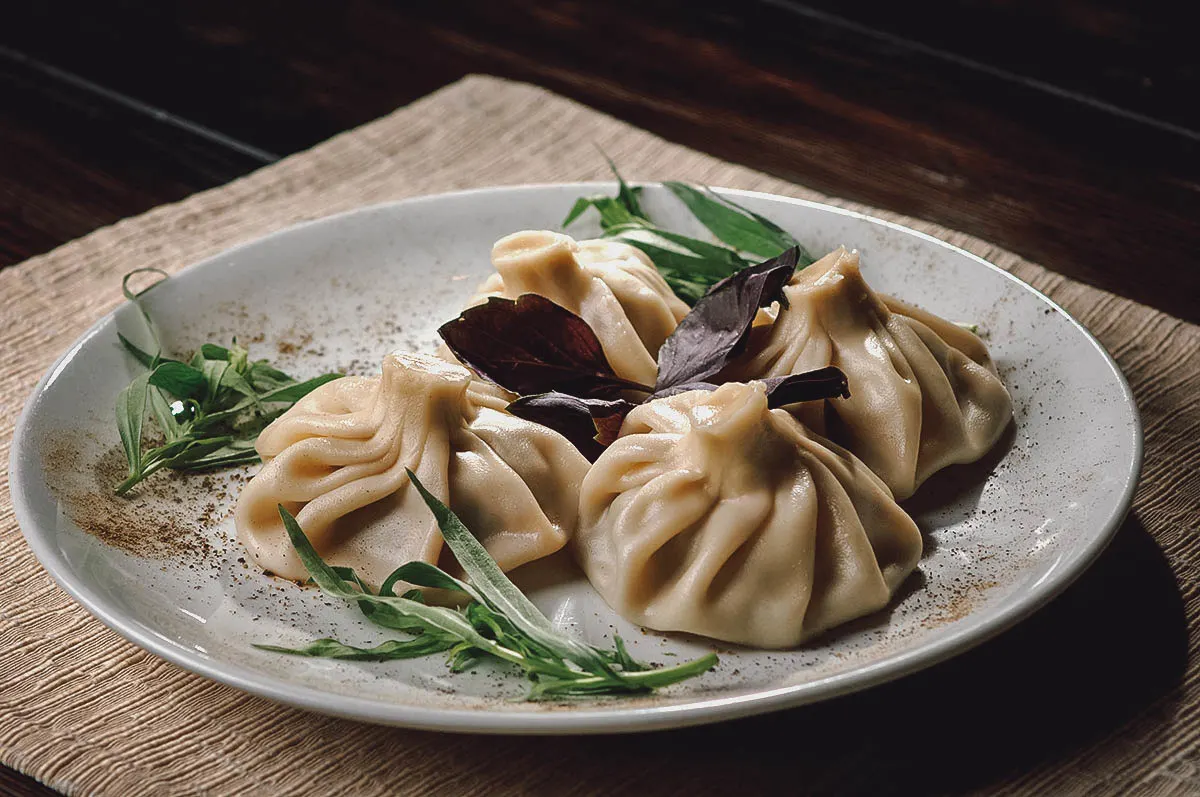
Photo by fotoluxstudio
2. Tolma
Tolma is the Georgian equivalent of dolma, a family of stuffed vegetable dishes that’s widely consumed throughout the South Caucasus, the Balkans, Central Asia, and the Levant. They consist of different vegetables or leaves stuffed with a mixture of rice, ground meat, herbs, and spices.
Georgian tolma can be made with different types of vegetables like tomato, eggplant, and zucchini, but in Georgian cuisine, the most common types are made with bell peppers and vine or cabbage leaves.
When made with peppers, the insides of the pepper are hollowed out before being stuffed with the filling. The stuffed peppers are then cooked in a mixture made with tomatoes, sour cream, garlic, and spices.
RECIPE: Tolma (stuffed peppers)
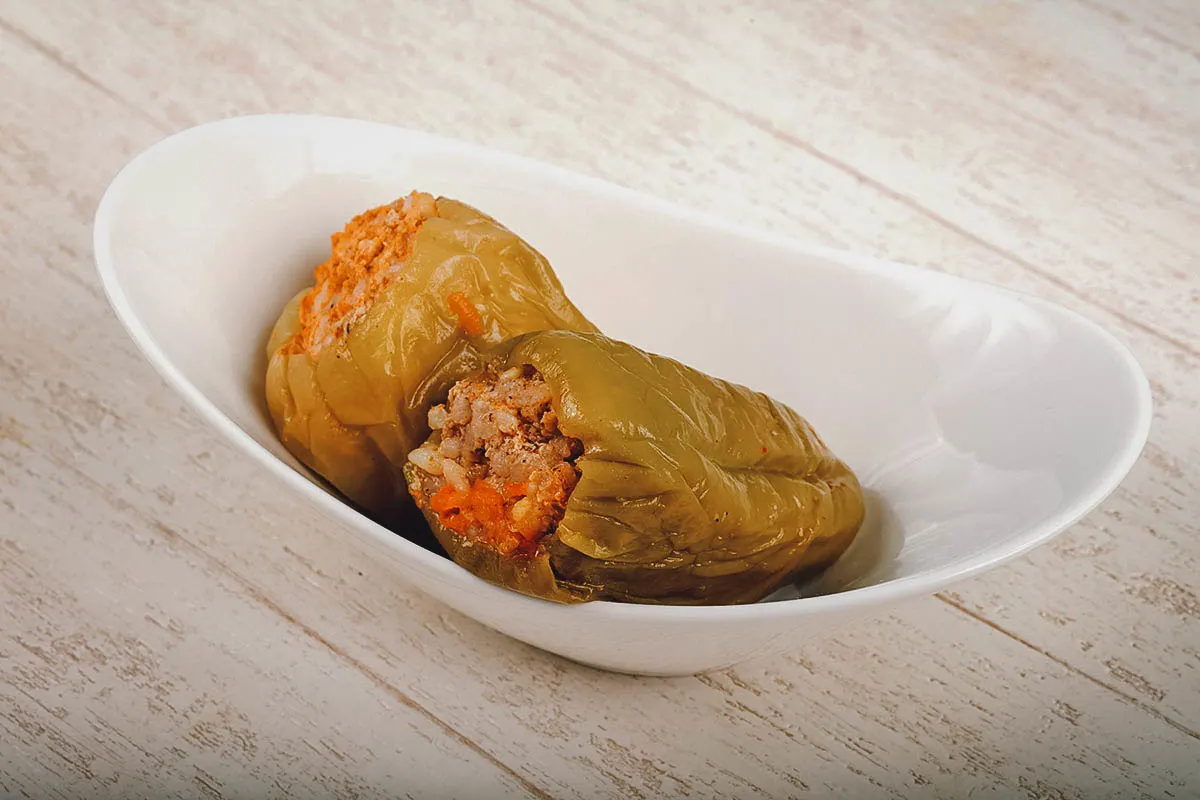
Photo by AndreySt
Tolma made with cabbage or vine leaves is very similar except the filling is wrapped inside the leaves instead of being stuffed in a vegetable. Other than the vessel, the ingredients remain mostly the same.
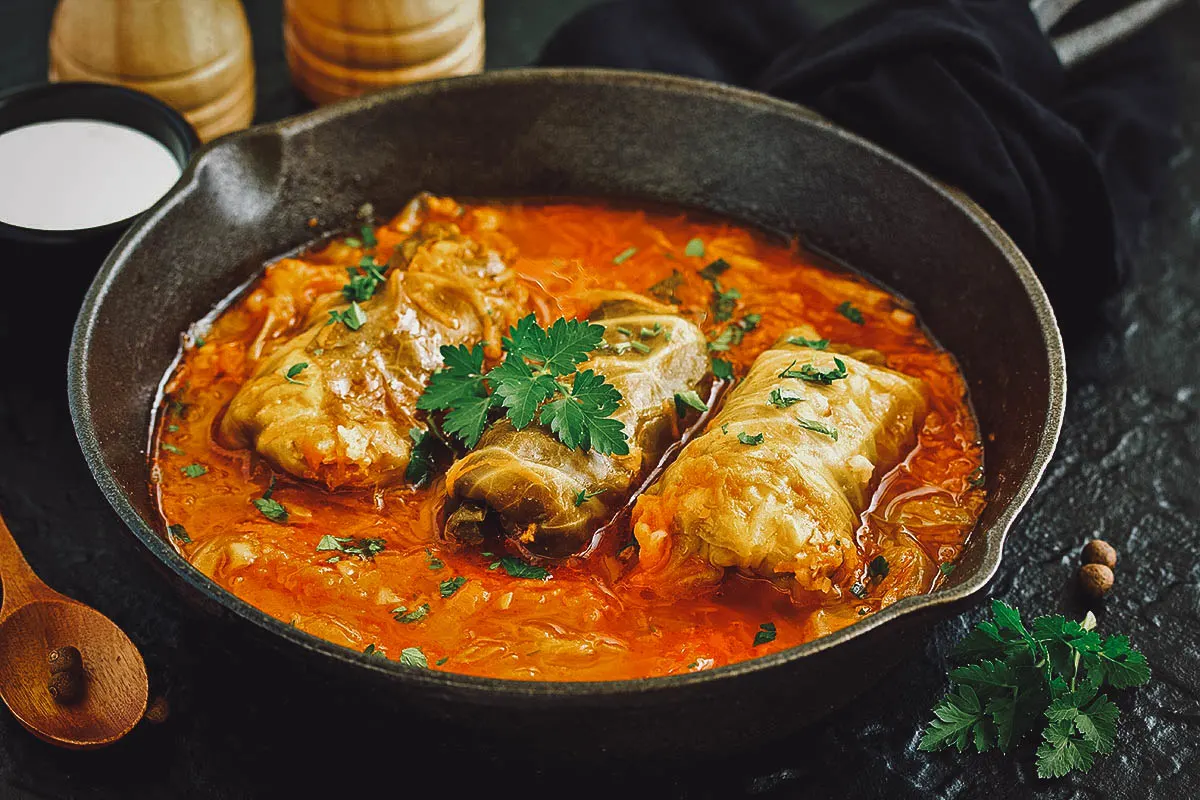
Photo by ld1976
3. Pkhali
Pkhali (or mkhali) refers to a family of Georgian appetizers made with any type of cooked vegetable mixed with ground walnuts, garlic, herbs, and spices. Commonly served at Georgian restaurants, it’s like a type of cold vegetable pate or spread that’s traditionally eaten with Georgian griddled corn cakes called mchadi.
Pkhali can be made with different types of vegetables like spinach, beetroot, white beans, cabbage, eggplant, carrots, or squash. They take the color of whatever vegetable they’re made with so they can range in appearance from a pale orange to a deep green to an intense purple. Typically shaped into balls, they’re often garnished with pomegranate seeds and served as the first course at supras.
Traditionally, pkhali was known as poor people’s food, something Georgians ate when they couldn’t afford meat. People would gather whatever edible weeds they could find and make a meal out of it by mixing them with a paste made from walnuts or hazelnuts.
RECIPE: Pkhali
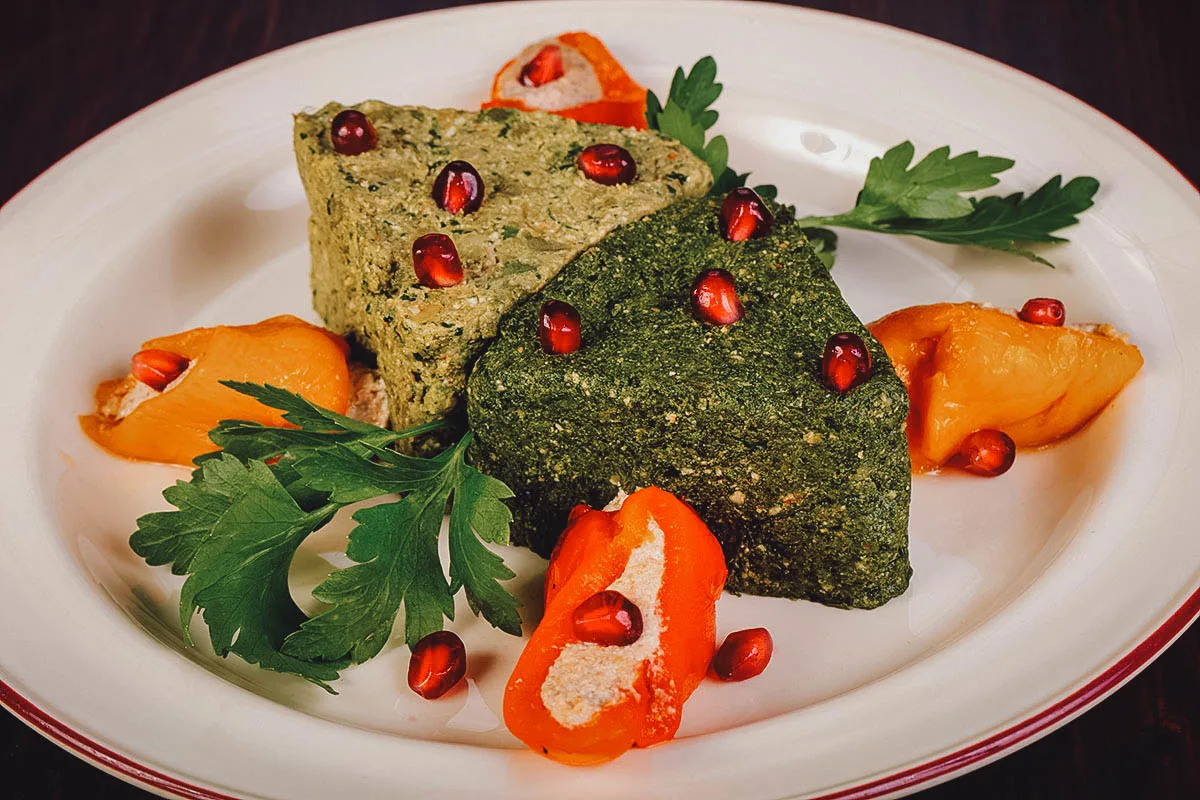
Photo by AndreySt
4. Ajika
Ajika (or adjika) refers to a spicy Georgian-Abkhazian condiment made from red peppers, garlic, salt, and spices. It can be eaten fresh as a dip or used as a flavoring agent to enhance many Georgian dishes like grilled meat, fish, soup, vegetables, and salad.
Ajika is typically made with sun-dried red peppers though it can be made with unripe peppers as well. In that case, the ajika is green instead of the more common red. Georgian ajika is made only with peppers but a less spicy adaptation containing tomatoes is popular in Russia and Ukraine as well.
RECIPE: Ajika
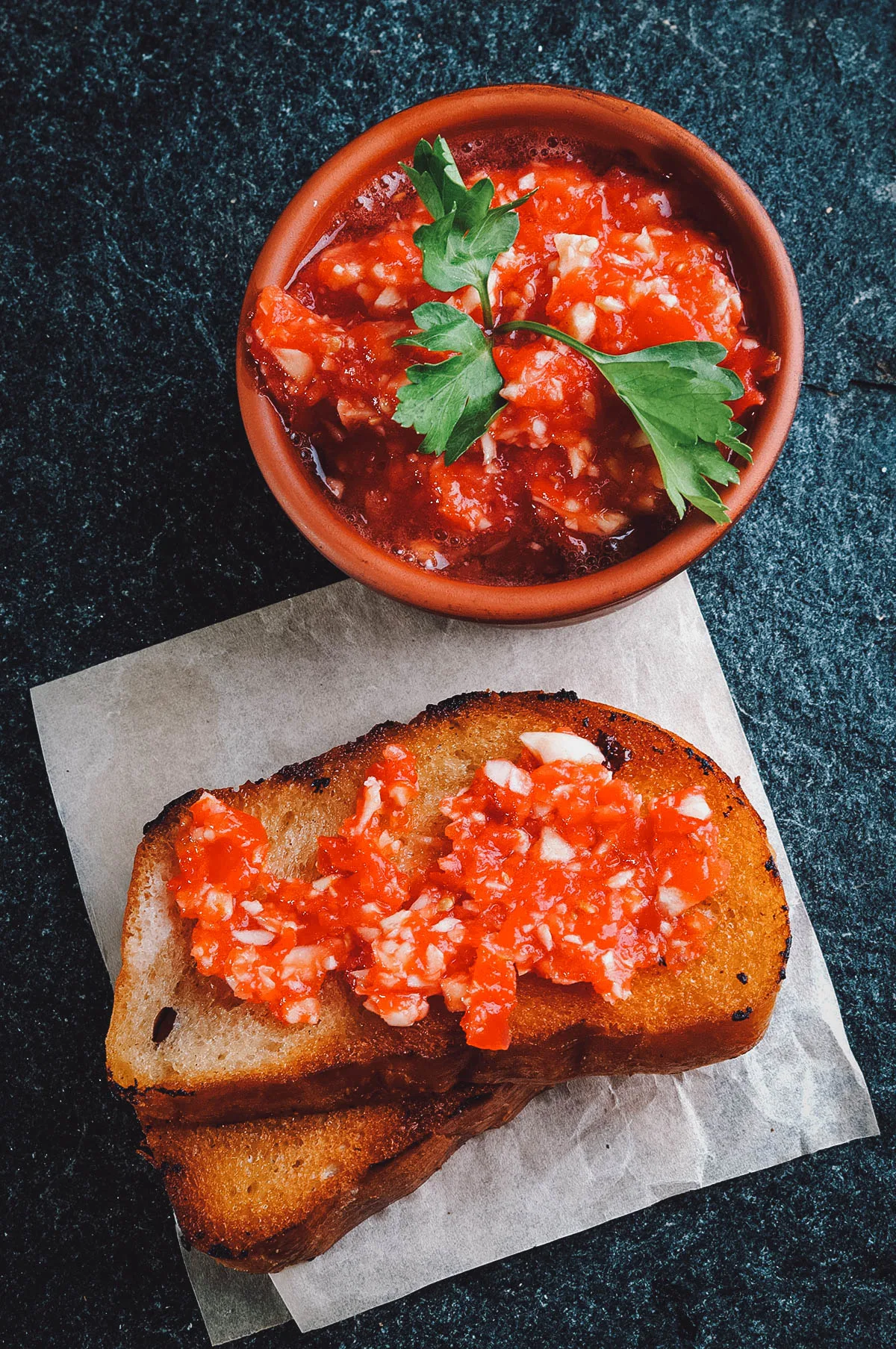
Photo by nanka-photo
5. Satsivi
Satsivi refers to a thick walnut paste or sauce made from walnuts, garlic, vinegar, dried herbs, red pepper, and salt . It’s always served cold (tsivi means “cold” in Georgian) and used in a variety of poultry, fish, and vegetable dishes.
The name satsivi refers to the sauce but it can also be used to describe the dishes made with the sauce. Throughout the year, satsivi dishes are usually made with chicken but traditional satsivi, which is often prepared for Christmas and New Year, is made with turkey.
RECIPE: Satsivi
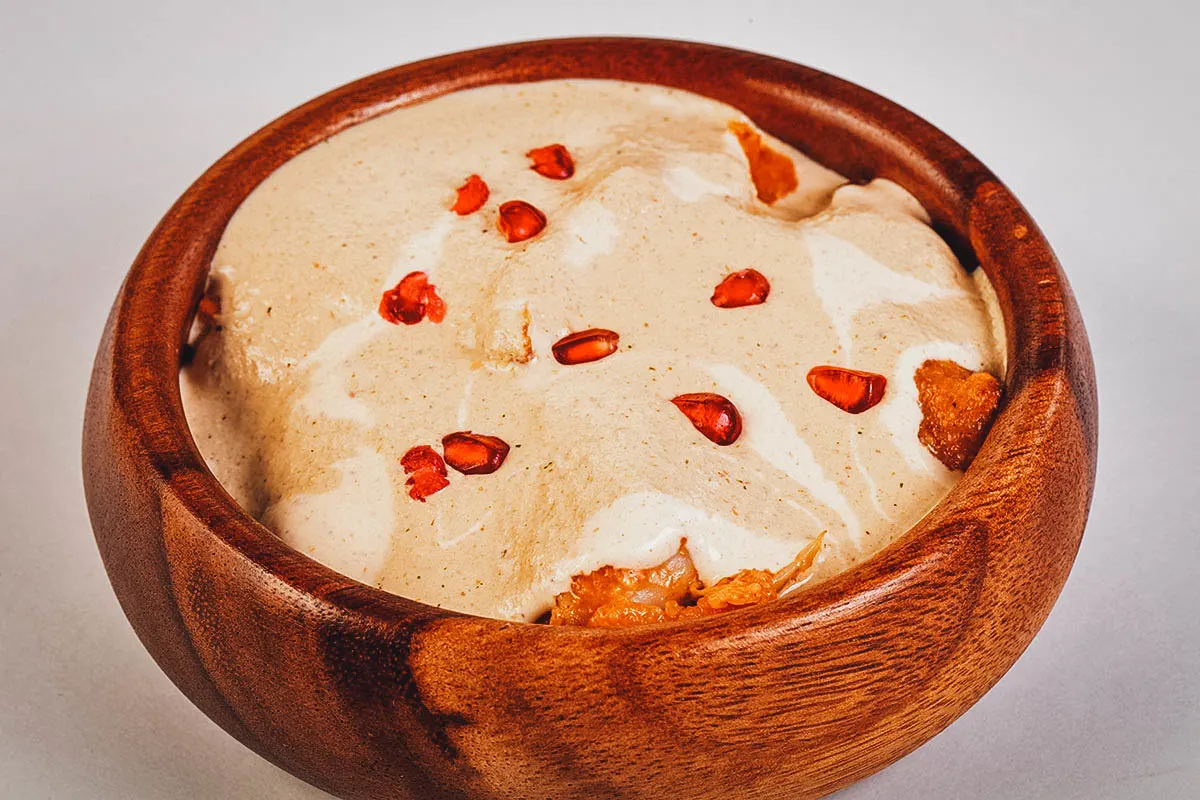
Photo by AndreySt
6. Gebzhalia
Originally from the Samegrelo region, gebzhalia refers to a Georgian cheese dish consisting of softened cheese served in a creamy sauce made from nadughi or matsoni. Nadughi is a type of soft Goergian cottage cheese while matsoni refers to a fermented milk product very similar to yogurt.
To prepare, a mixture of crushed mint, green peppers, garlic, and salt is placed over a layer of boiled and softened Georgian cheese. With the mint mixture on the inside, the cheese is carefully rolled up and cut into small portions. The portions are then plated and poured over with a sauce made from nadughi or matsoni and the same mint mixture.
RECIPE: Gebzhalia
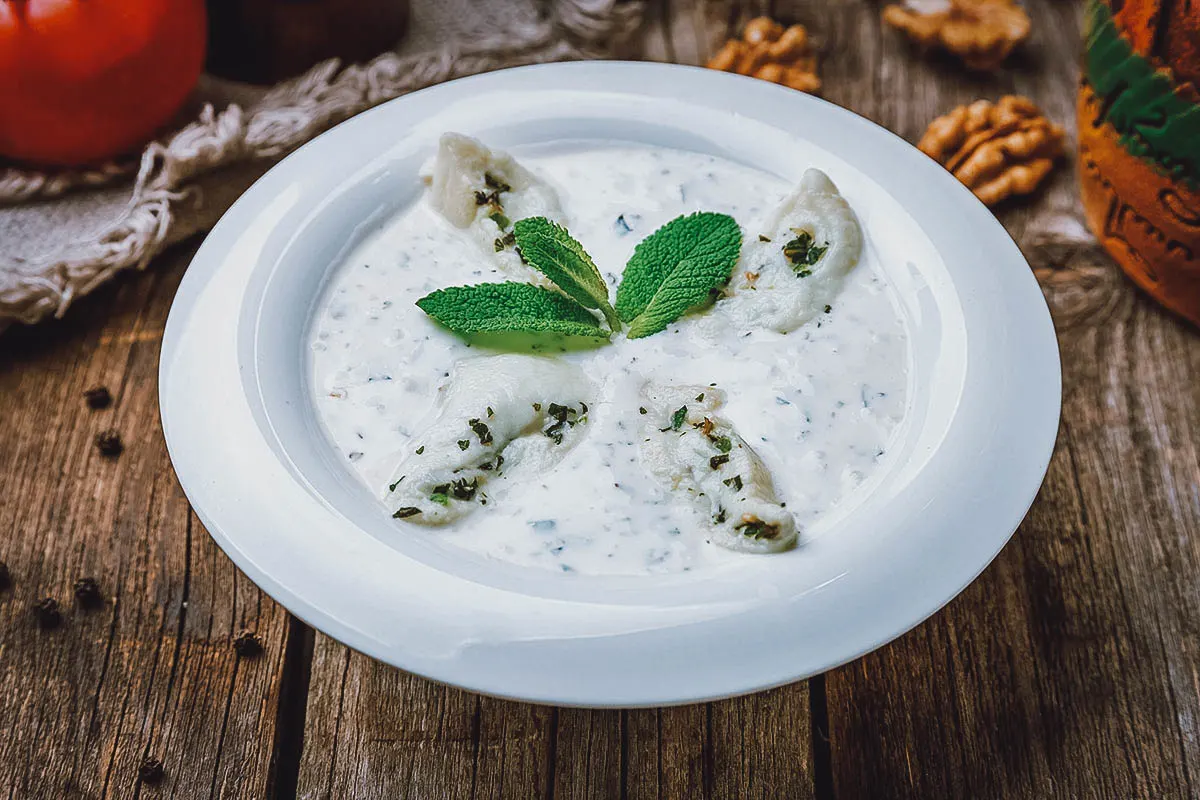
Photo by bbivirys
7. Ajapsandali
Ajapsandali refers to a traditional Georgian vegetable dish made with different stewed vegetables like eggplant, tomatoes, potatoes, onions, green peppers, and bell peppers. They’re stewed till tender with seasonings like garlic, dry coriander, ground red pepper, black pepper, and salt.
Ajapsandali is typically consumed as part of a Georgian family meal. You can think of it as the Georgian version of ratatouille. It’s also popular in Armenia and in parts of the North Caucasus.
RECIPE: Ajapsandali
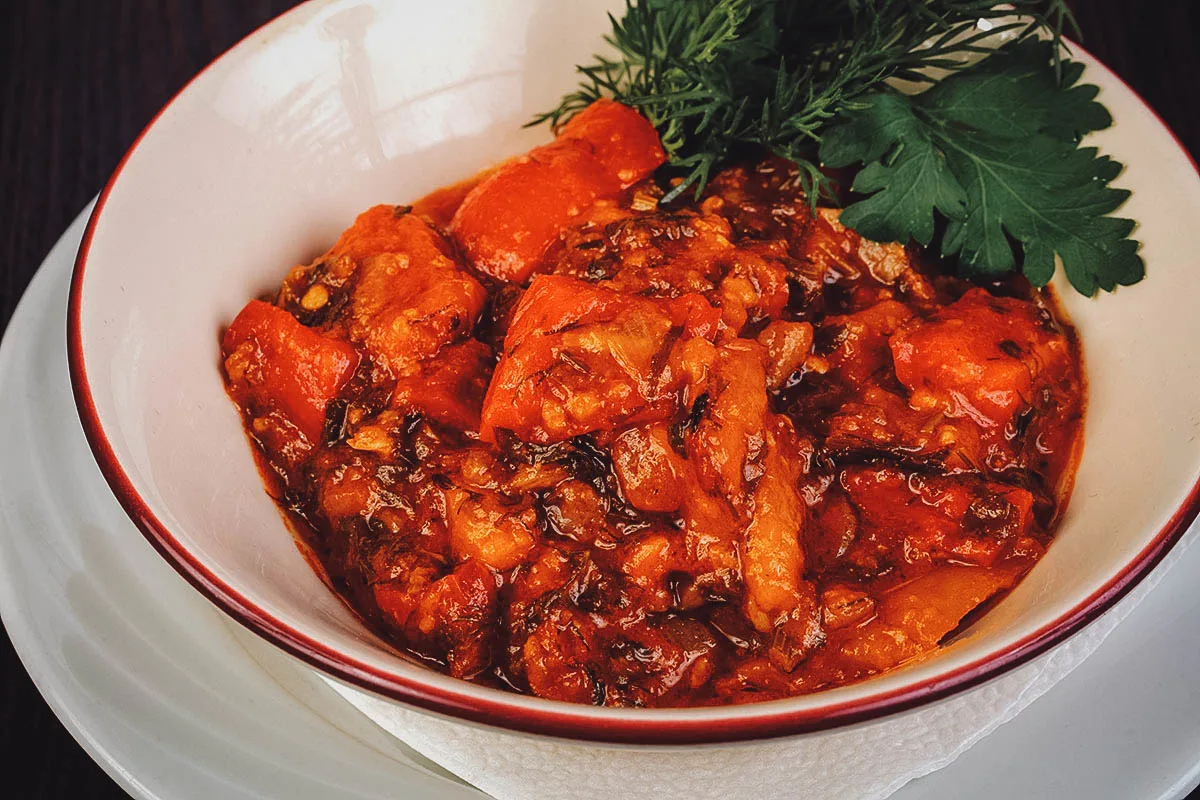
Photo by AndreySt
8. Lobio
Lobio refers to a popular Georgian bean soup or stew made with kidney beans. It exists in many varieties and can be prepared with cooked or stewed beans flavored with herbs and spices like coriander, garlic, onions, bay leaves, and blue fenugreek. Depending on the version, it can be served hot or cold and is typically eaten with mchadi or Georgian cornbread.
One of the most common types of lobio in Georgia is a cold version called lobio nigozit. It’s typically made with cooked red kidney beans that are mashed with garlic, onions, walnuts, coriander, chili pepper, marigold petals, and vinegar. Hot versions of lobio may contain meat and are often served in a clay pot with mchadi.
RECIPE: Lobio
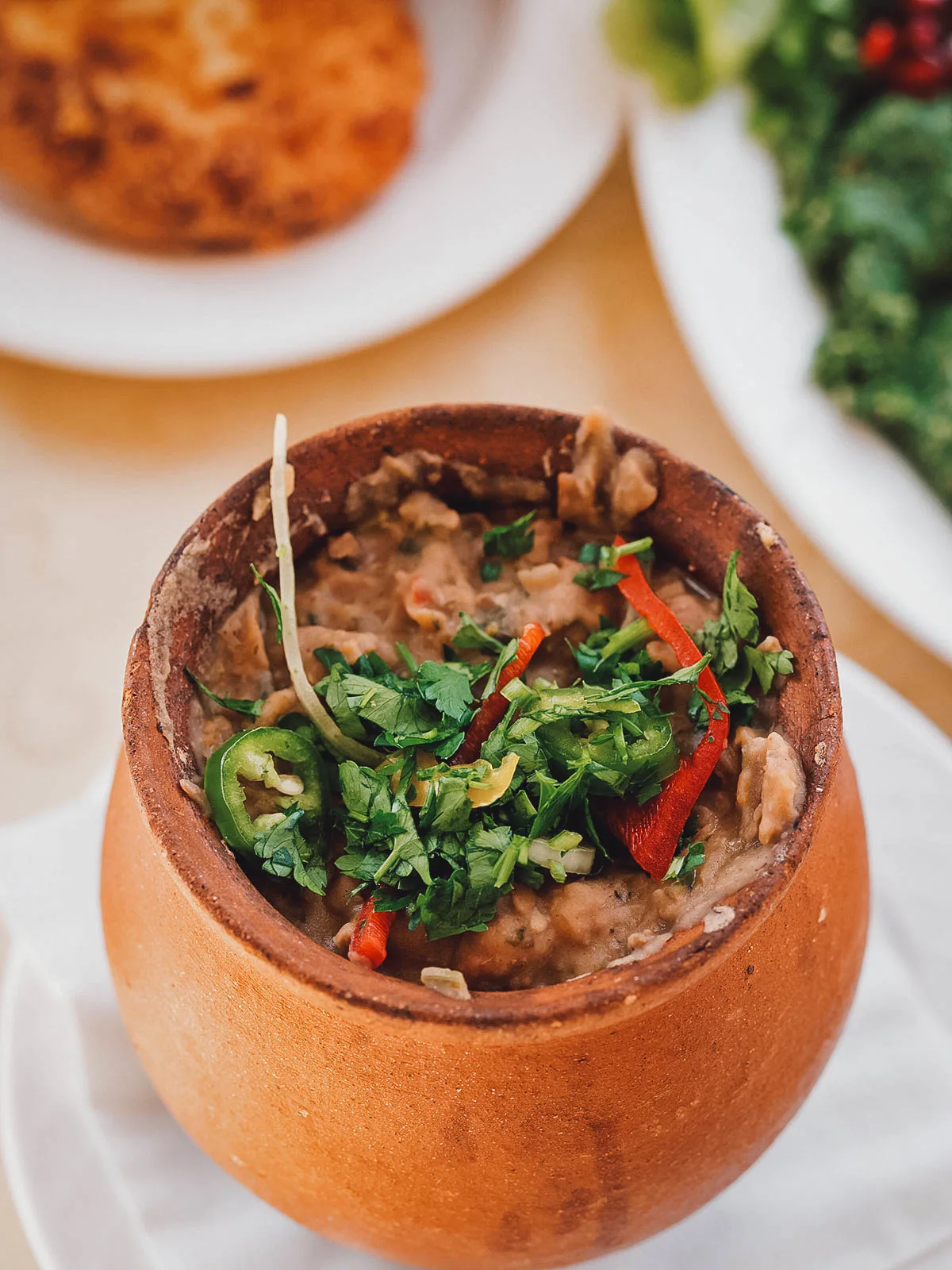
Photo by magdalena.paluchowska
GEORGIAN BREAD
9. Khachapuri
Khachapuri is one of the most beloved Georgian foods. Like khinkali, it’s a popular comfort food and widely considered to be a Georgian national dish.
Khachapuri refers to a traditional Georgian dish consisting of cheese-filled bread. The bread can be shaped in various ways, typically with the cheese in the middle and a surrounding crust that can be broken off and dipped into the cheese. Aside from a specialized khachapuri cheese, the filling can contain eggs and other ingredients as well.
This beloved cheese bread is widely available throughout Georgia, both at Georgian restaurants and as street food. It exists in many shapes and variations but the most popular form is Imeretian khachapuri. It’s made with a yeast-infused pastry and white Imeretian salted cheese.
RECIPE: Khachapuri
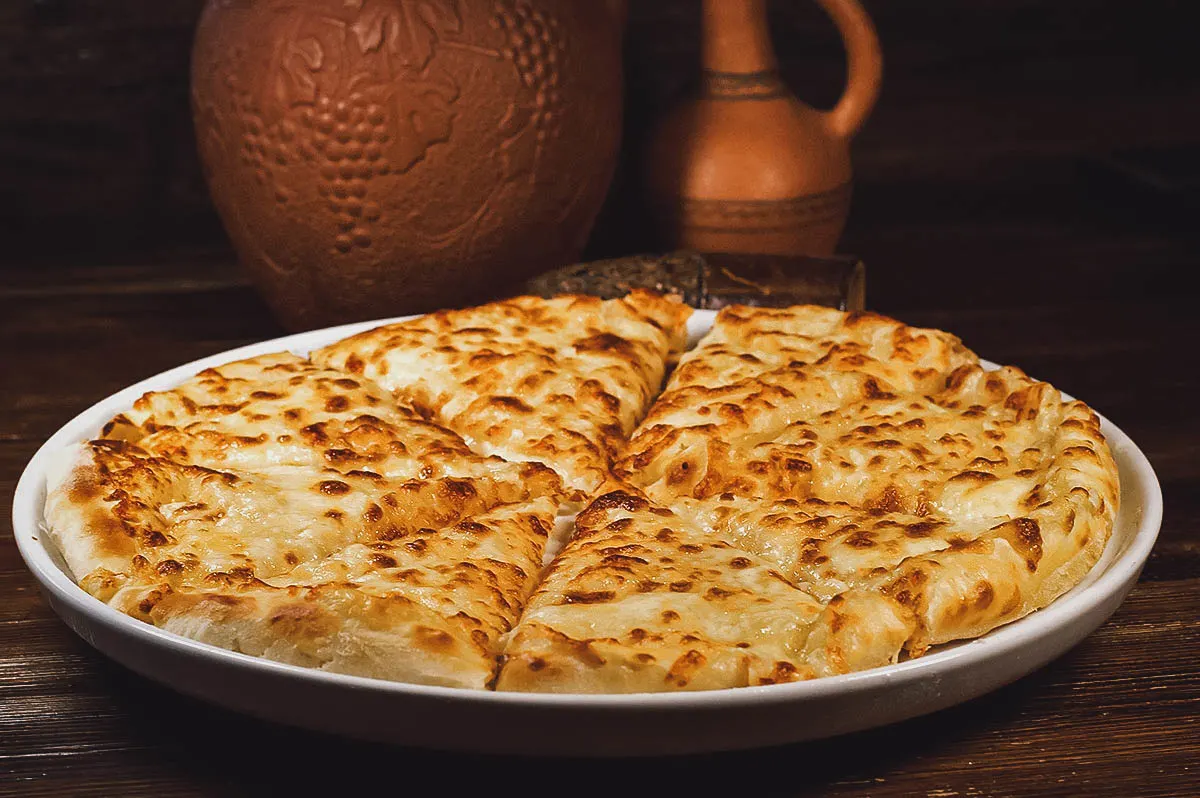
Photo by KrystynaTaran
Imeretian khachapuri may be the most common type of cheese bread in Georgia but thanks to social media, Adjarian khachapuri may be the most famous internationally. It refers to a boat-shaped khachapuri made with cheese, butter, and a raw egg yolk in the middle.
Adjarian khachapuri (or adjaruli khachapuri) is believed to have been invented by the Laz people of Georgia. They’re a seafaring ethnic group who live mainly in the Black Sea coastal regions of Georgia and Turkey. This type of khachapuri is said to represent a boat, the sea, and the sun.
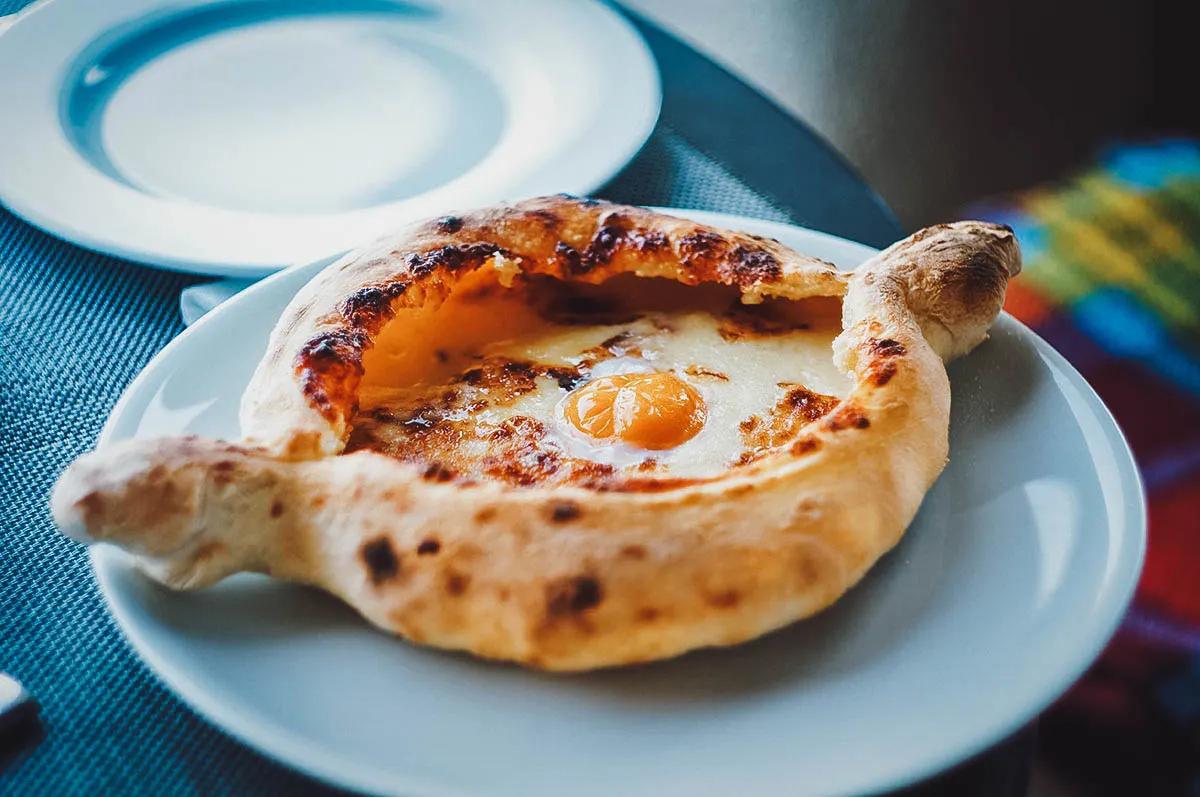
Photo by Elet_1
Interestingly, khachapuri is such an important Georgian food that the cost for making it is used as a measure of inflation in Georgia. It’s called the “khachapuri index” and was developed by the International School of Economics at Tbilisi State University.
Pictured below is achma, a type of khachapuri that’s made with multiple layers and resembles a sauceless lasagna. Other popular forms of khachapuri include Khabizgini, Megrelian khachapuri, and Penovani khachapuri.
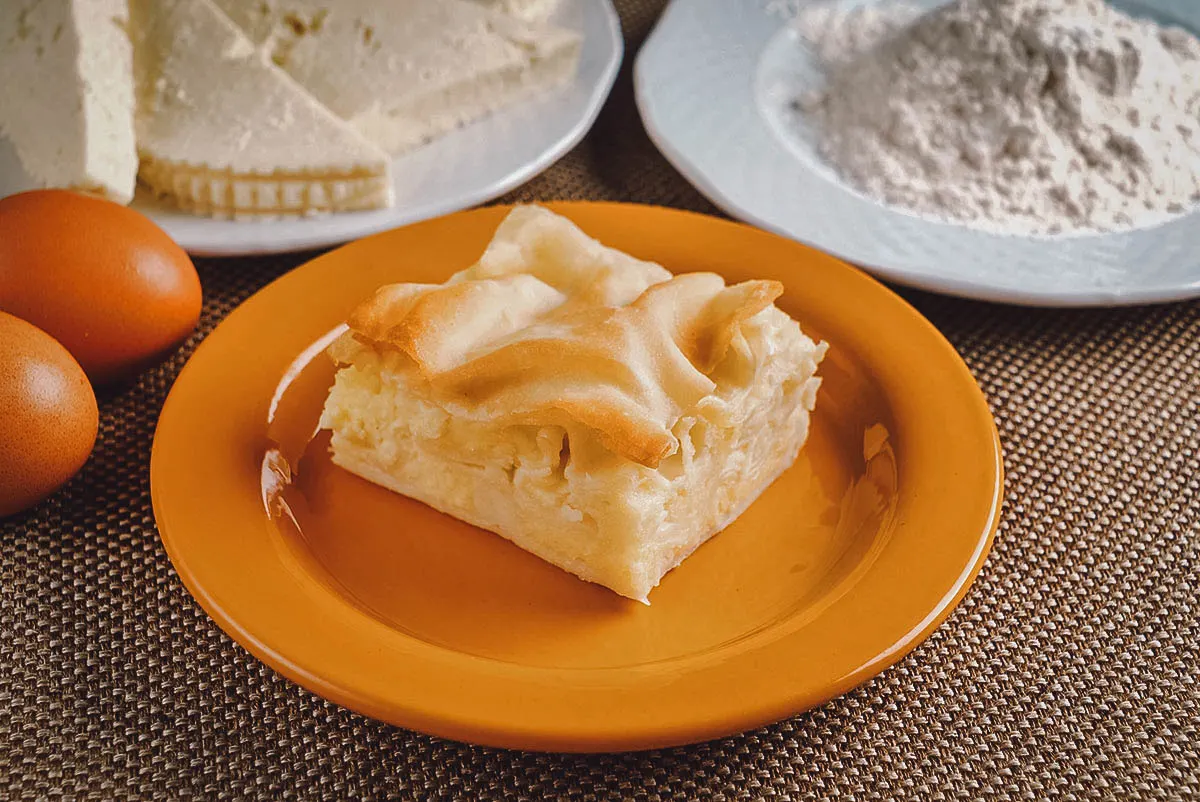
Photo by Shebeko
10. Kubdari
Kubdari (or kuptaari, kubed) refers to a type of Georgian bread filled with meat, onions, garlic, and spices. Originally from Georgia’s Svaneti region, it’s sometimes referred to as “Svanetian khachapuri” even though it isn’t made with the cheeses that define Georgian khachapuri.
Kubdari can be made with beef, pork, goat, or lamb that’s cut into chunks instead of being minced. The meat is mixed with onions, garlic, and a host of spices like cumin, coriander, fenugreek, and dill before being stuffed into the dough and baked.
Once baked to a golden brown, the kubdari is glazed with butter and served while still hot.
RECIPE: Kubdari
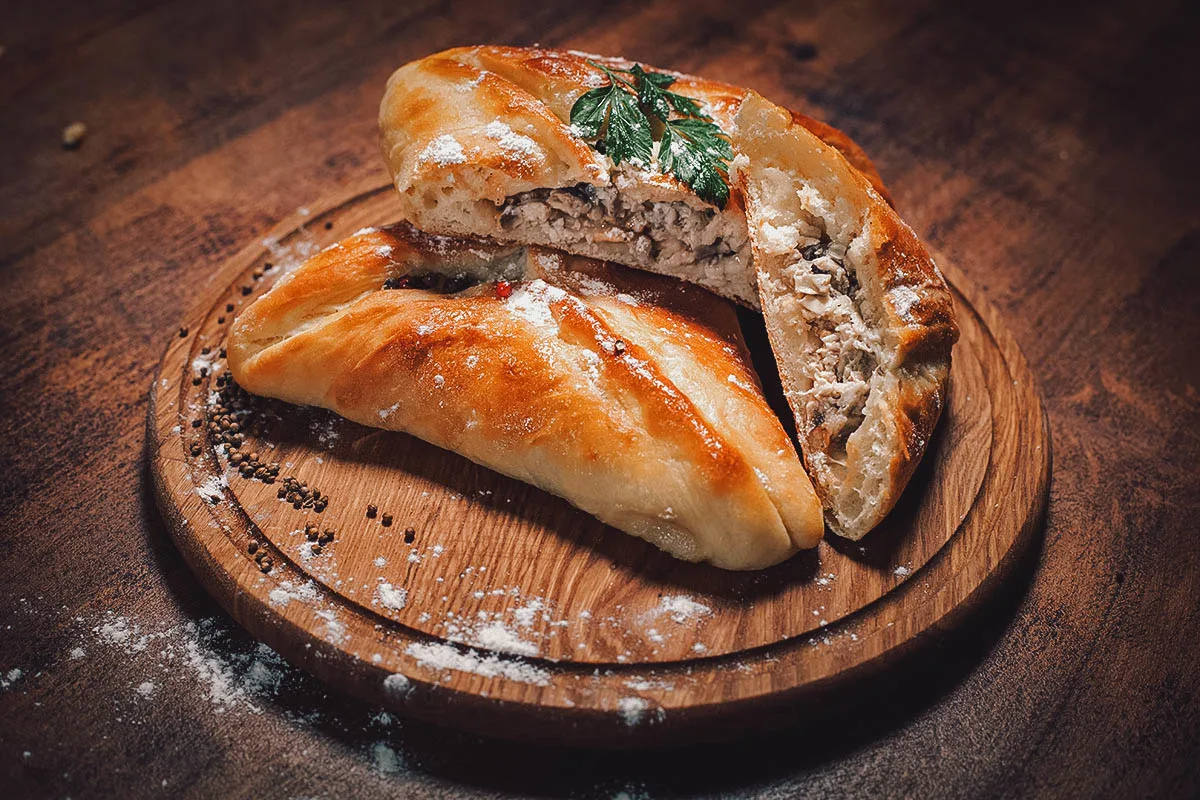
Photo by goami
GEORGIAN SOUPS / STEWS
11. Kharcho
Kharcho (or harcho) refers to a Georgian soup made with fatty cuts of beef (usually chuck or brisket), rice, chopped walnuts, cherry plum puree, and khmeli-suneli – a traditional spice mix that’s used to flavor many Georgian dishes and sauces.
This intriguing spice mix has been described as Georgia’s national spice blend. It’s made with coriander seed, basil, marjoram, dill, red pepper powder, saffron, fenugreek, bay leaf, mint, celery, and parsley. Together with the cherry plum puree that acts as a souring agent, it’s what gives this rich and hearty Georgian soup its characteristic flavors.
Kharcho is typically served with chopped fresh coriander and crusty bread and is a favorite soup in winter. Pair it with a glass of good Georgian wine for a truly warming meal.
RECIPE: Kharcho
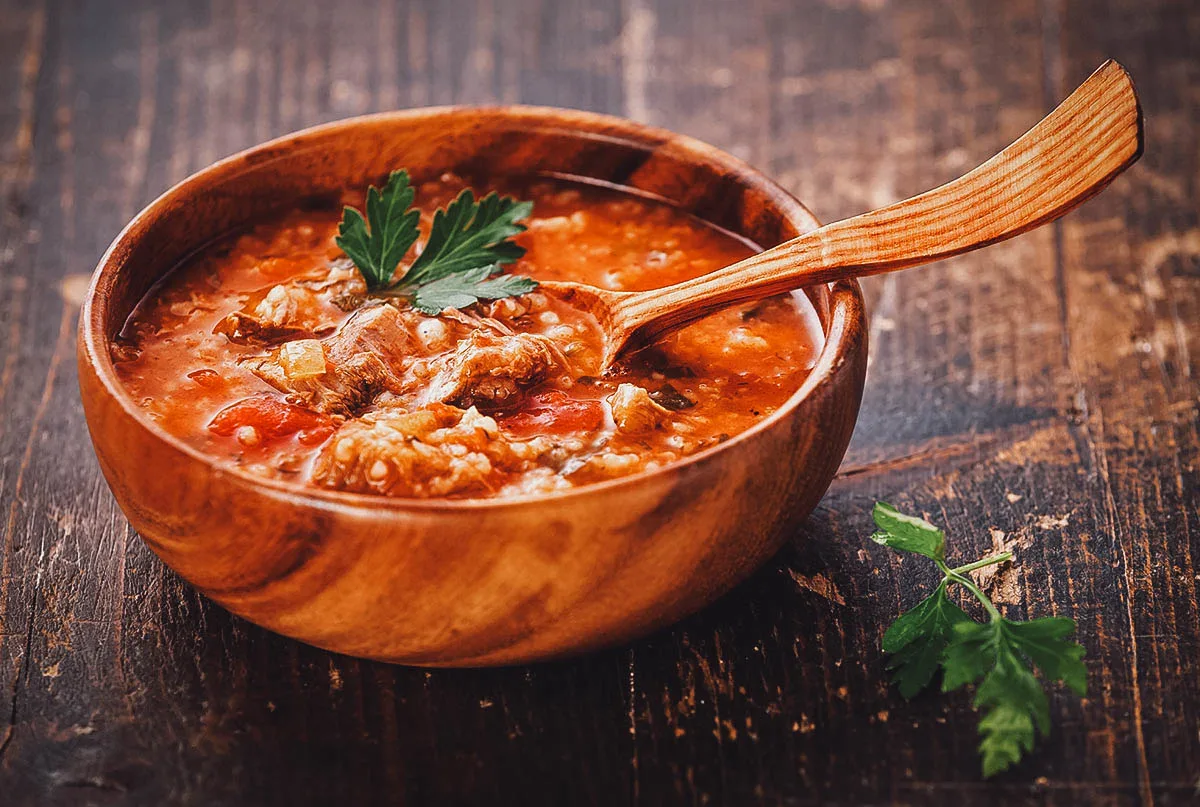
Photo by lisovskaya
12. Chakhokhbili
Chakhokhbili is a hearty Georgian stew made with chicken, tomatoes, and fresh herbs. It’s an easy-to-prepare one-pot dish made with a whole chicken chopped up and simmered with fresh tomatoes, onions, garlic, herbs, and spices.
Modern versions of the dish are made with chicken but It was traditionally prepared with pheasant hence the name chakhokhbili. Chakhokhbili is derived from the Georgian word khokhobi meaning “pheasant”.
Like kharcho, chakhokhbili is usually garnished with chopped fresh cilantro and paired with crusty bread or rice.
RECIPE: Chakhokhbili
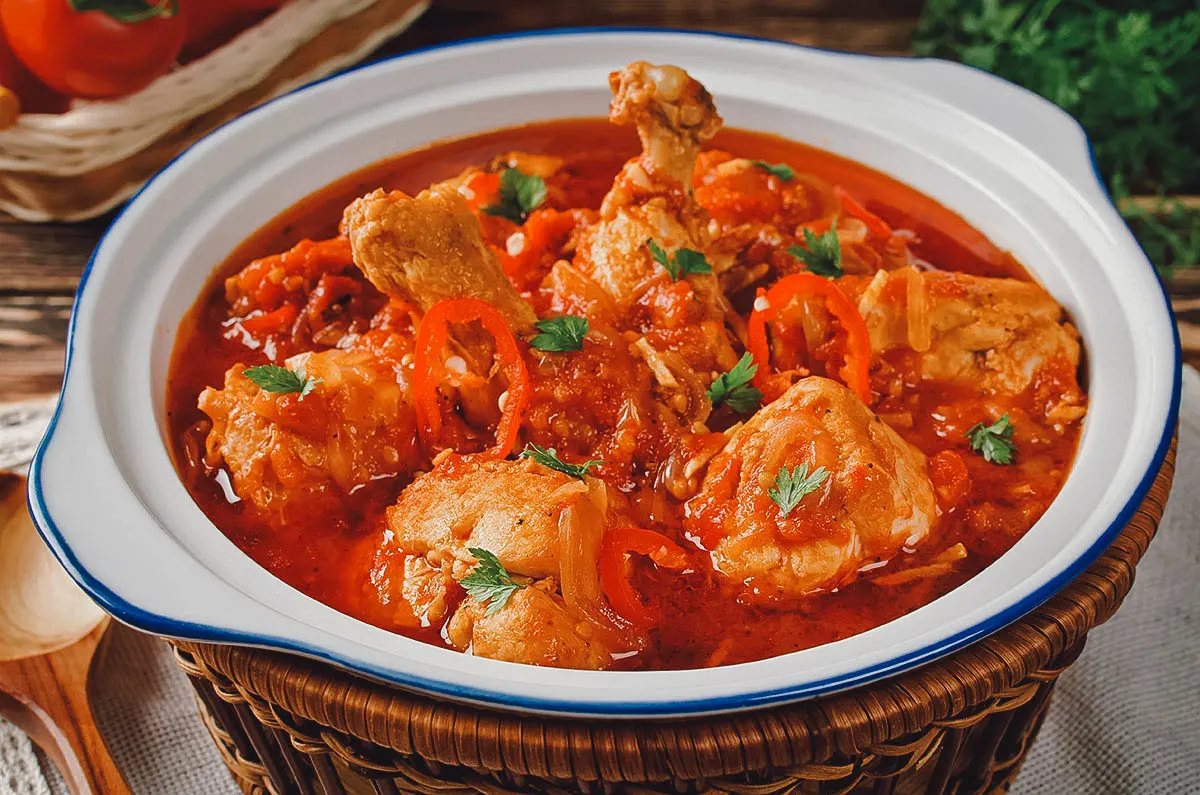
Photo by vkuslandia
13. Chashushuli
Chashushuli refers to a Georgian meat and tomato stew. It’s typically made with beef though it can be made with veal or pork as well. Other key ingredients include onions, garlic, and a generous amount of herbs and spices like basil, parsley, fenugreek, chilli pepper, summer savory, and bay leaves.
To prepare, the beef is cut into thin pieces and fried with onions. Chopped peeled tomatoes, crushed garlic, and spices are then added and left to simmer with the beef. When ready, the chashushuli is garnished with chopped parsley and served with Georgian bread like shoti.
RECIPE: Chashushuli
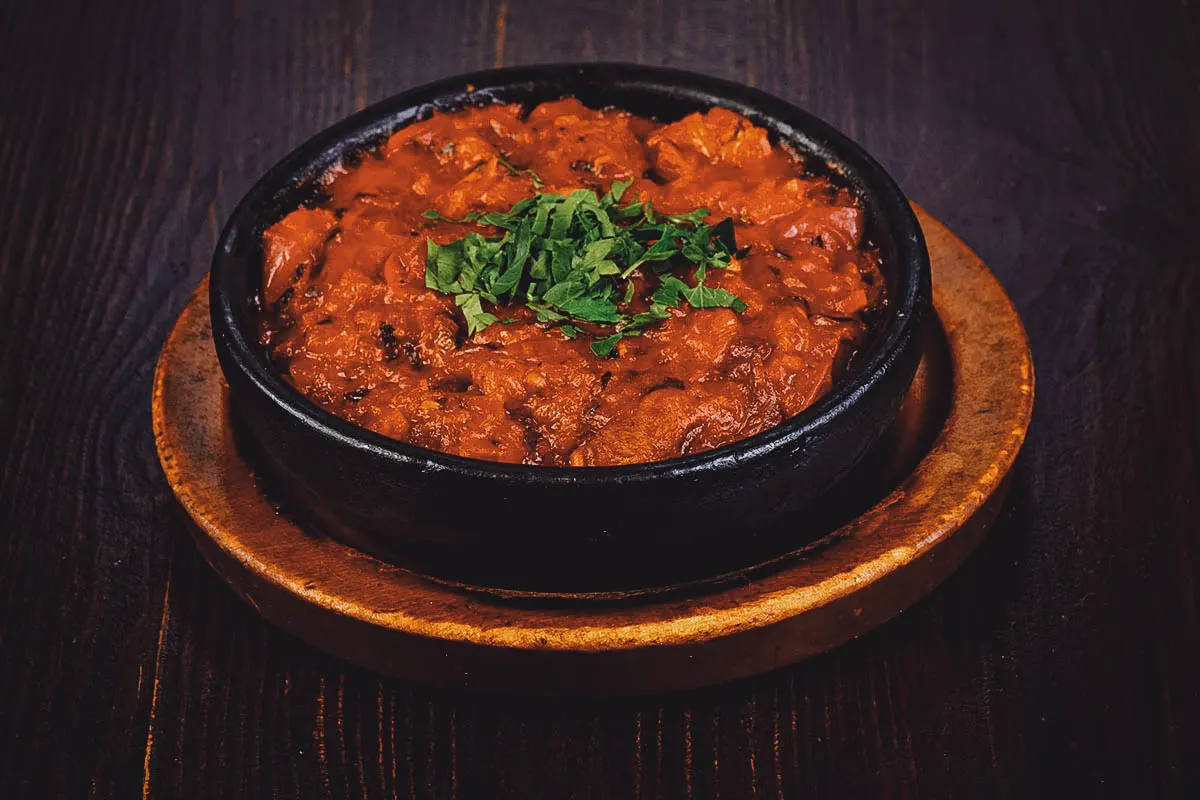
Photo by AndreySt
14. Khashi
Khashi refers to a type of Georgian meat soup made with boiled cow or sheep parts. It typically contains various organ meats though it can be made with the head and hooves as well.
To prepare, the meats are thoroughly cleaned before being boiled over a low flame for several hours. While boiling, carrots and onions may be added for flavor. When ready, milk and salt are added to the soup which can sometimes be served with garlic paste, greens, and sliced bell peppers.
Khashi is originally an Armenian dish (where it’s known as khash) but it’s widely consumed in different variations and names throughout the Caucasus, the Balkans, Central Asia, and the Levant. It’s a highly nutritious soup that’s often touted as a hangover remedy.
It’s believed that khash started off as poor people’s fare. After the choice animal meats were distributed among the rich, the poor were left with the head, hooves, and organ meat which they would turn into a soup to consume in the morning.
RECIPE: Khashi
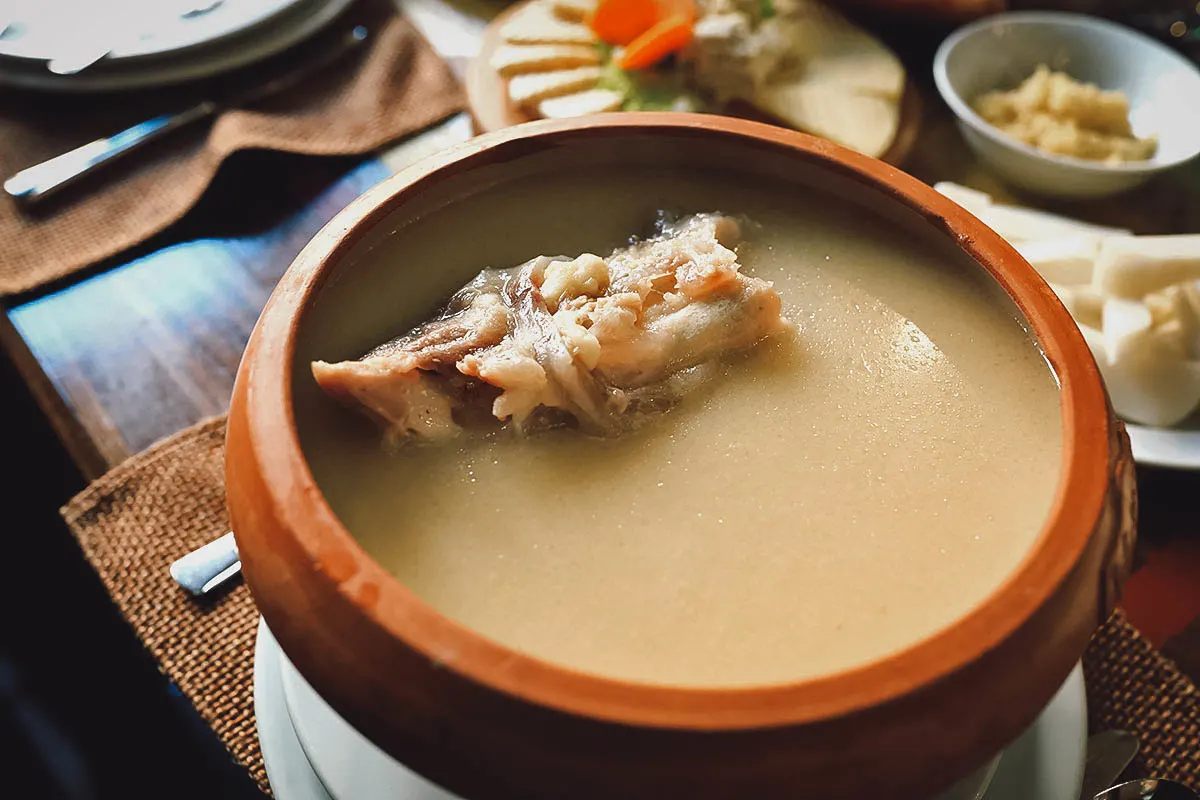
Photo by AChubykin
GEORGIAN MEAT DISHES
15. Mtsvadi
Mtsvadi refers to the Georgian equivalent of the shish kebab. It consists of marinated cubes of meat that are skewered and then grilled over an open fire. It’s typically made with pork, mutton, or veal, though beef can be used as well.
To prepare, the cubes of meat are marinated in a mixture containing onion, ajika, coriander seeds, bay leaves, pomegranate juice, salt, and spices. They’re then threaded onto skewers and grilled over charcoal. Often, dried vine clippings are thrown into the grill to make the coals more fragrant.
Similarly skewered and grilled meat dishes are popular throughout the Caucasus and Central Asia. In Russia, it’s known as shashlik.
RECIPE: Mtsvadi
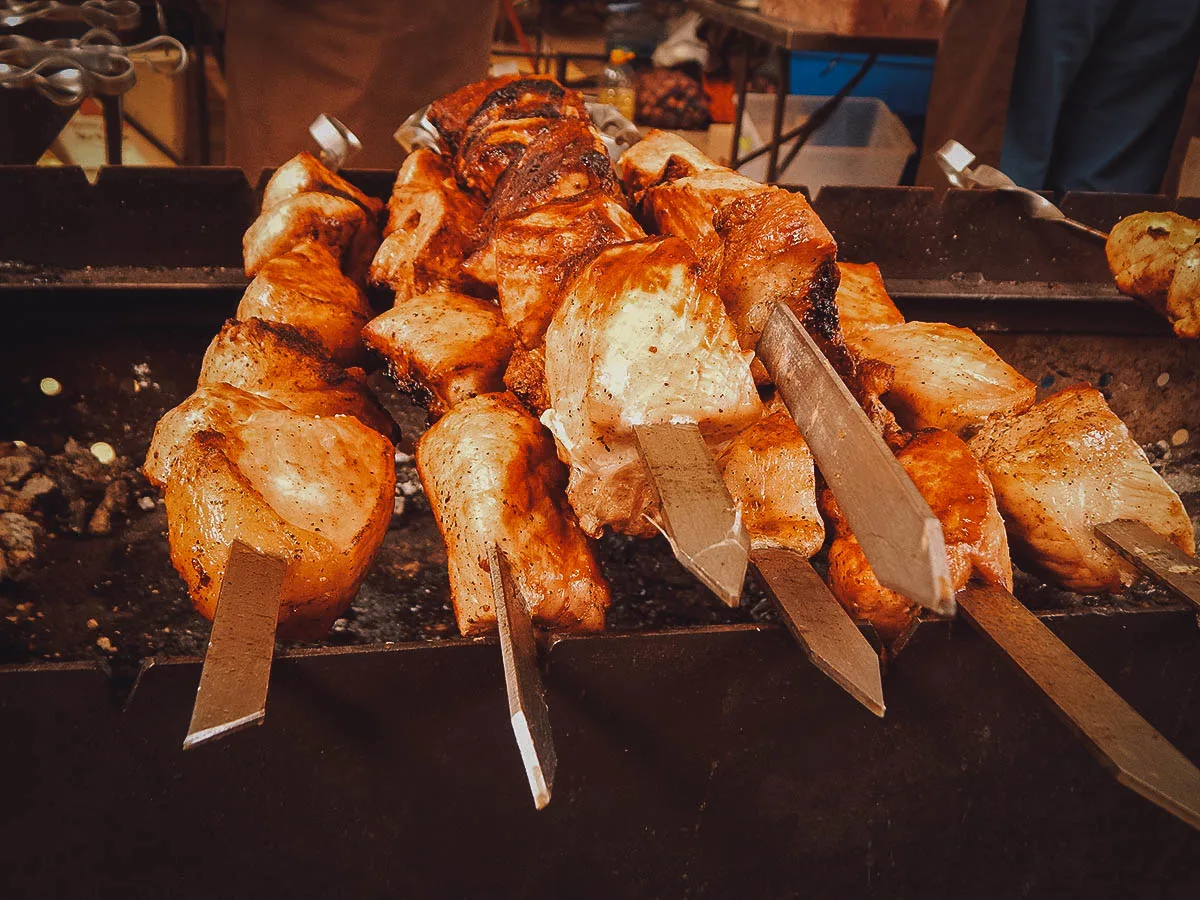
Photo by AnyVidStudio
16. Chicken Tabaka
Chicken tabaka (or tapaka) refers to a traditional Georgian pan-fried chicken dish. It’s popular throughout the Caucasus and gets its name from the traditional frying pan called tapa that’s used to cook the dish.
To prepare, a whole chicken is butterflied and then flattened out on the tapa with the aid of a weight. Traditionally, the chicken is seasoned lightly with just salt and perhaps some red chili powder before being fried on both sides in butter. It’s typically served with cilantro, basil, and sliced green or white onions on the side.
RECIPE: Chicken tabaka
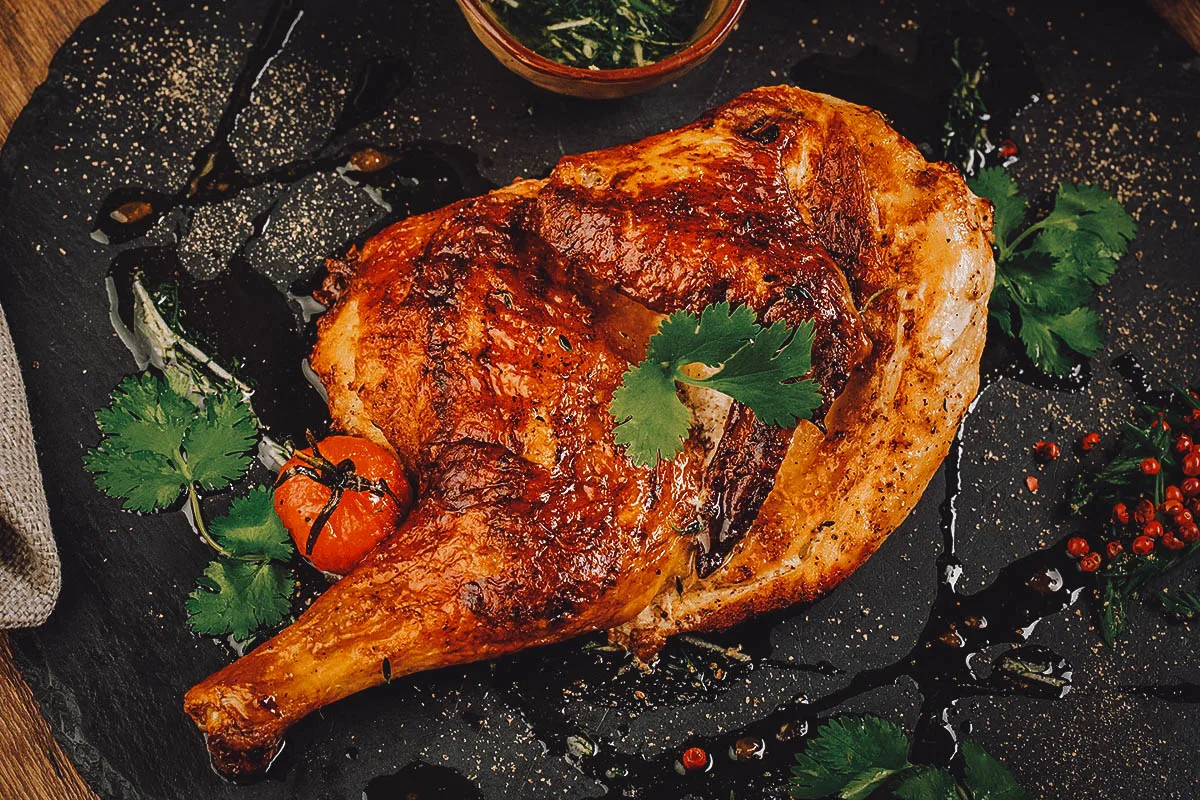
Photo by kaninstudio
17. Khashlama
Khashlama refers to a traditional boiled meat and vegetable dish. It’s a simple but time-consuming dish made with beef or lamb that’s boiled for several hours with onions, garlic, bay leaves, black peppercorn, and salt. It’s popular in the Kakheti region of Georgia where it’s almost always served at supras.
Khashlama is consumed in both Armenian and Georgian cuisines. Its roots are disputed with some claiming that it’s an Armenian dish while others say it’s Georgian in origin.
Regardless of its true origins, khashlama is a delicious dish that you need to try in Georgia. Pair it with some good Georgian wine for a truly satisfying meal.
RECIPE: Khashlama
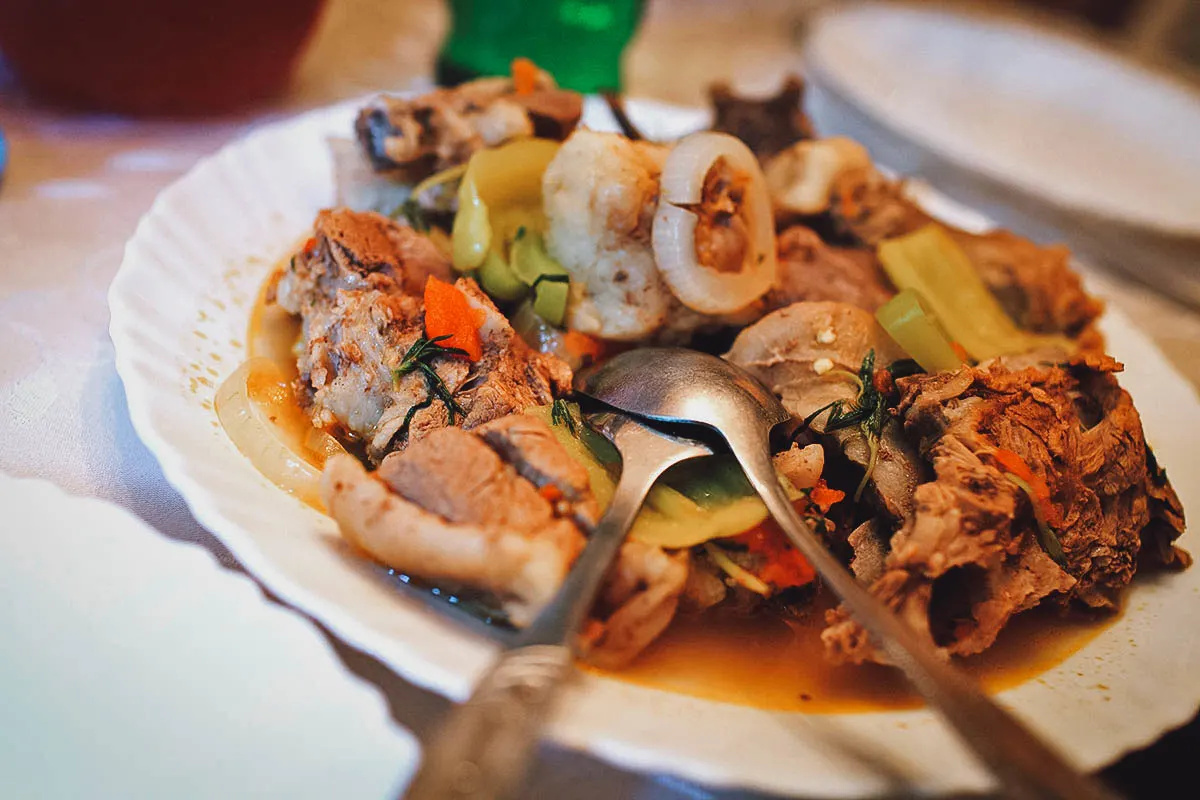
Photo by AChubykin
GEORGIAN DESSERTS
18. Churchkhela
These odd-looking Georgian treats are known as churchkhela. Resembling candles or small sausages, they’re actually Georgian candies made with nuts or dried fruit dipped in a fruit syrup made from concentrated grape juice (badagi), sugar, and flour.
Nuts like walnuts, almonds, or hazelnuts are strung together and repeatedly dipped in the fruit syrup known as tatara. They’re air-dried and dipped over and over until they form a waxy fruity buildup. Nuts are the most common ingredient but they can also be made with dried fruit like apples, peaches, or plums.
Historically, Georgian soldiers were known to snack on churchkhela before entering battle. They’re compact and have a long shelf life so they made for an ideal-high-calorie energy source. In the West, they’re sometimes referred to as “Georgian Snickers bars”.
Churchkhela is popular in many variations throughout the region and goes by different names like rojik (Armenia), cevizli sucuk (Turkey), and soutzoukos (Greece).
RECIPE: Churchkhela
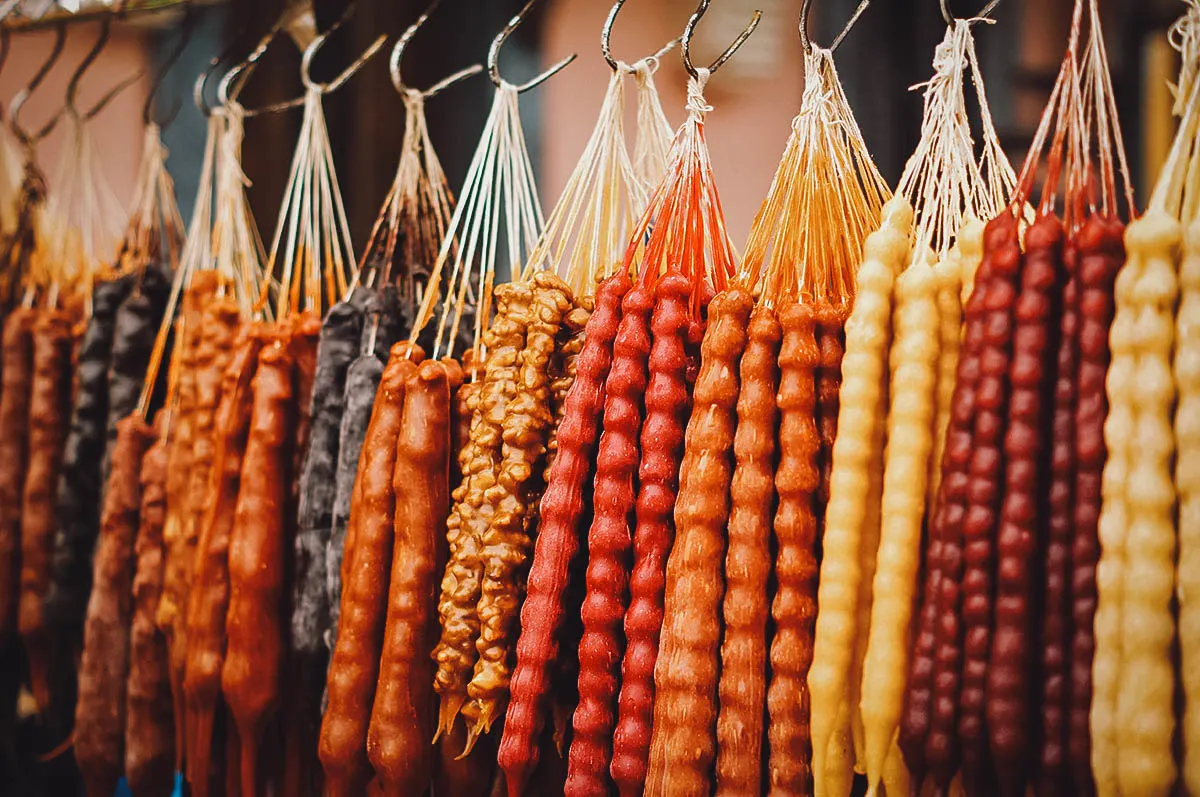
Photo by Elet_1
19. Tklapi
Tklapi refers to thin sheets of cooked fruit puree that have been left to dry in the sun. Resembling colorful sheets of leather, you can think of it as the Georgian version of Fruit Roll-Ups.
Tklapi can be sour or sweet and made with different fruits like apricots, peaches, wild plums, pears, or figs. They can be eaten on their own as a snack or used to flavor Georgian dishes like kharcho.
RECIPE: Plum tklapi
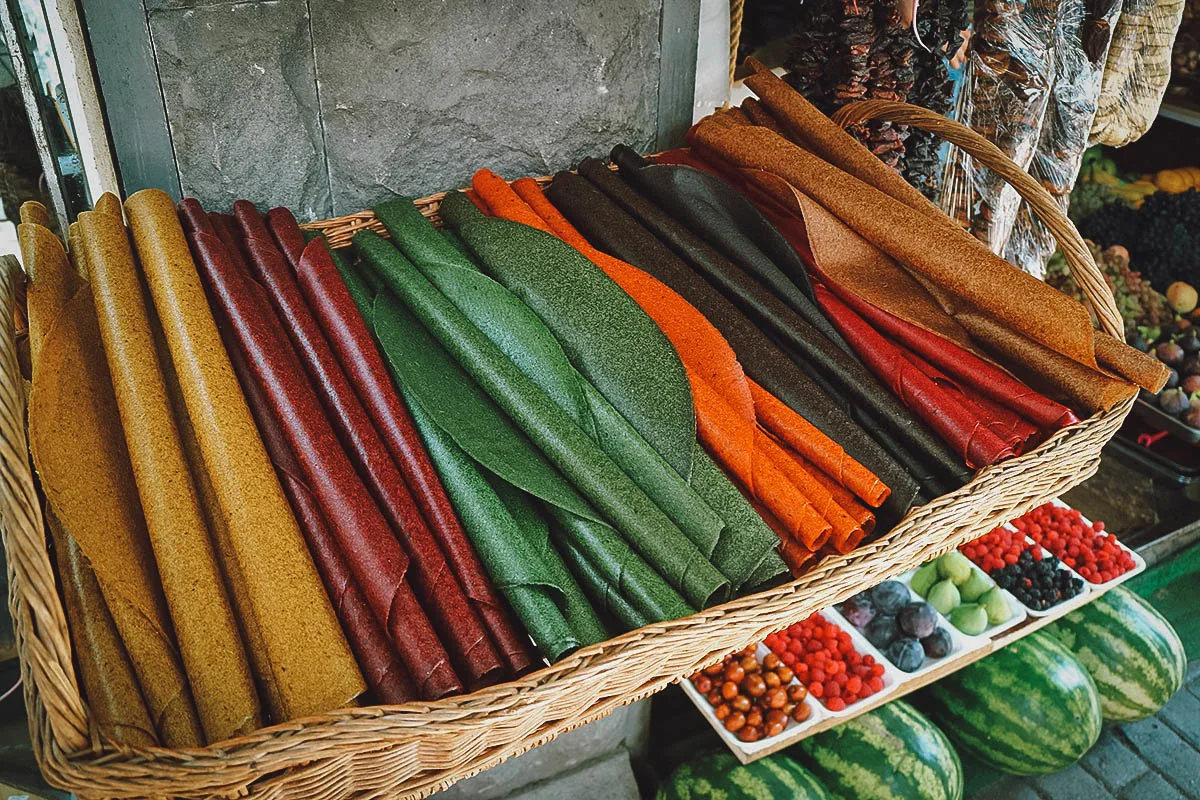
Photo by shinylion
20. Gozinaki
Gozinaki refers to a traditional Georgian brittle made with caramelized nuts like walnuts, almonds, or hazelnuts fried in honey. They’re usually cut into diamond shapes and are almost always present on Georgian dinner tables during Christmas and New Year’s Eve.
RECIPE: Gozinaki
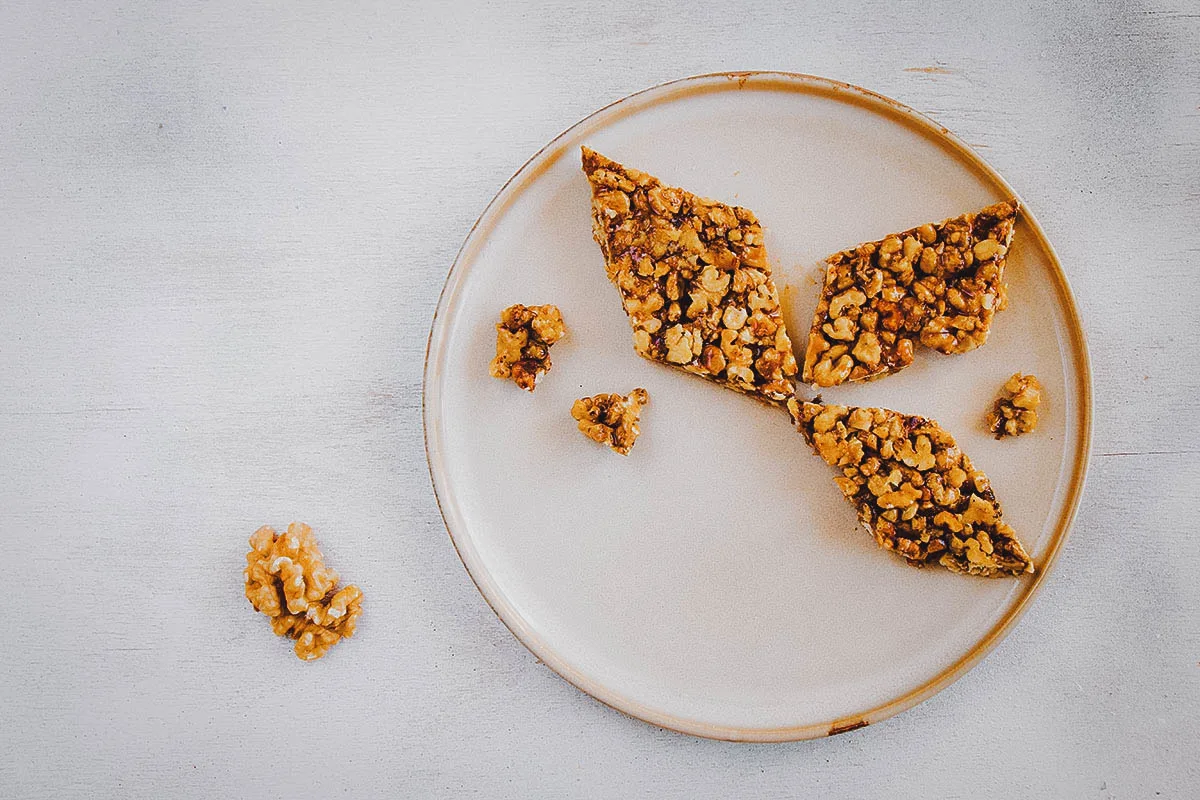
Photo by [email protected]
GEORGIAN FOOD TOURS
It goes without saying that no one knows Georgian food better than a local, so what better way to experience Georgian cuisine than by going on a food tour? A knowledgeable guide will lead you to the city’s best Georgian restaurants and markets so all you need to do is follow and eat. Check out Get Your Guide for a list of Georgian food tours in Tbilisi and beyond.
FINAL THOUGHTS ON GEORGIAN FOOD
Stumbling home from a supra will teach you that Georgian food is a hearty cuisine that’s meant to be shared and to bring people together. For centuries, it’s been a way for Georgians to connect, communicate, and to share in each other’s joys and sorrows.
The importance of the supra in local culture is best exemplified in a popular Georgian creation story. According to the legend, God created the world and divided it among the different cultures. Georgians were last in line because they woke up late after celebrating a supra the night before. God was so impressed with their honesty that He gave them the best land of all, a portion He was saving for Himself.
Simply put, the supra is the ultimate manifestation of Georgian food and hospitality and something that every Traveleater should hope to experience.
Disclosure
Some of the links in this article on Georgian food are affiliate links. We’ll earn a small commission if you make a booking at no added cost to you. As always, we only recommend products and services that we use ourselves and firmly believe in. We really appreciate your support as it helps us make more of these free travel and food guides. Thank you!
Cover photo by Roxana. Stock images via Depositphotos.


Alex
Tuesday 7th of September 2021
Good job from non Georgian person, having that much information about our cuisine. But one thing that is more related to History than to cuisine is that Georgians were living and creating fine jewelery, arts, fortifications etc earlier than 10th century BC, when turks only settled in 15th century. So it's less likely that people with such a history and culture, copied something, even cuisine from other less cultured people.
JB & Renée
Tuesday 7th of September 2021
Thanks for stopping by Alex. If all goes well, I'll be in Tbilisi in January so I'm looking forward to learning more about your cuisine and culture.
Mariam Shotadze
Thursday 26th of August 2021
Where is Chakapuli? It id made of lamb or veal and lot's of greens, including pursly bsby onions baby garliv cilantro, taragon and most importantly, Georgian green plum Tkemali. Also vinegar and/or white wine should be added. Furthermore, Tkemali souce is missing from your list.
JB & Renée
Friday 27th of August 2021
Thanks for the recommendation Mariam! I'll be traveling to Georgia soon so I'll definitely expand this list.
rusiko
Thursday 15th of July 2021
Most importantly! "Chakaful" is not written!
JB & Renée
Friday 23rd of July 2021
Thanks for the recommendation rusiko. Plannins a trip to Tbilisi in October. Will definitely look for that.